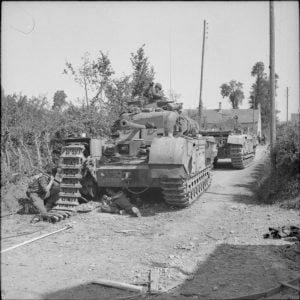Some people might not know, but the history of the Second World War has a rich community of enthusiasts on the internet. People love analysing battles, personalities and, of course, weapons. However, there is one area of the history of the Second World War that is rarely touched upon and does not have as many enthusiasts as others. Do you know how tanks were repaired on the field during the biggest conflict in humanity’s history?

This article will not attempt to solve any mysteries of the WW2. It will not try to improve your knowledge about tank repair operations to an unprecedented level. Instead, it will briefly go through some interesting details of tank repairing that some people still get wrong. It is meant to invoke your interest and to show a peculiar side of military history that not many people think about.
Tanks were extremely important in the Second World War. In some places, people still believe in legends and myths that damaged tanks were left behind. While that certainly happened in some cases, tanks were usually rescued and repaired. Not only they were expensive to make, they were extremely valuable in a battle and different units could not afford to wait for new machines to arrive. If repairs were not possible (if the tank was too badly damaged), machines were salvaged for spare parts, so that lightly-damaged tanks could be brought back to battle.

Usually, the tanks were not heavily damaged at all, but were immobilized by broken tracks or minor powertrain problems. Abandoning such valuable vehicles was never an option. Therefore, special repair and rescue vehicles used to be sent into the battlefield to recover damaged tanks and other heavy machinery. Some of these vehicles were made using actual tank’s chassis, to give its crew more protection. They would pull immobilized tanks out of the military action zone so that they could be repaired in location or could be sent off to larger repair shops.

In some cases, crews had to improvise. For example, when tracks get broken and lack some segments, they are shortened – as long as they cover the driving star, the tank will move. Not very fast and not very smoothly, but it is certainly enough to move to a new spot for further repairs.

Sometimes working in field conditions required some unconventional methods and creativity. For example, when the British Churchill tanks were going through some field tests, crews struggled with gear selector levers – they were bending and breaking because of the light-duty metals used to make these rods. Mechanics quickly found a solution – semiaxles from Ford vehicles fit perfectly and were much stronger.

In Algeria there were many damaged Churchill tanks, but around 60 % of them sustained damage to the turret only, and were perfectly drivable. Meanwhile, there were two other problems – a large number of damaged Sherman tanks and the shortage of 6 pound ammunition for British tanks. Percy Morrell decided to take the action into his own hands and try and fit Sherman 75 mm gun to damaged Churchills.
Authentic video report about repair operations of American tanks
It took some fettling around, since in American tanks the loader sits on the left and the gunner on the right, while in British tanks their position was inversed. This meant that the breach opened to the wrong side. Morrell solved the problem by simply rotating the gun 180 degrees. The “new” tank was so effective that there was an immediate order to start converting damaged Churchill tanks like this everywhere and around 200 of Churchill NA 75 were made in total.

Tank repair was a task that required some hero characteristics from people. They had to be experienced mechanics, but also be able to work under pressure. A lot depended on these people, although now they are not as well known or researched as people who experienced war in front rows. Hopefully, we will revisit this topic in the future, to try and find more interesting details about tank repair operations in the Second World War.




